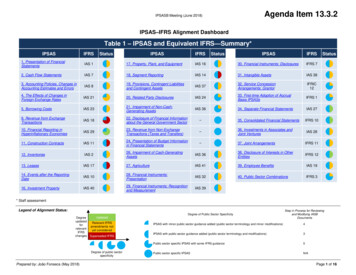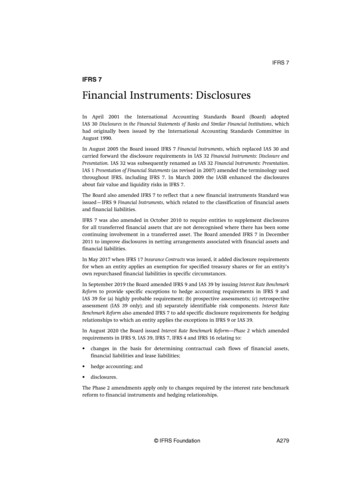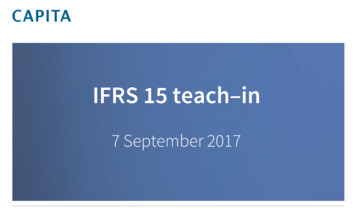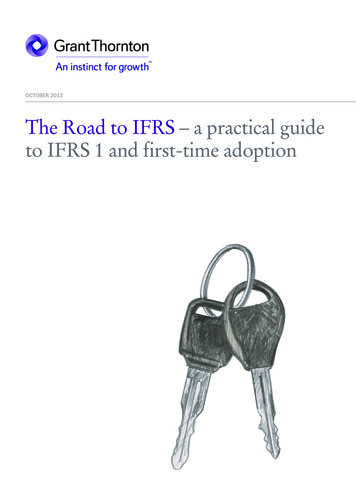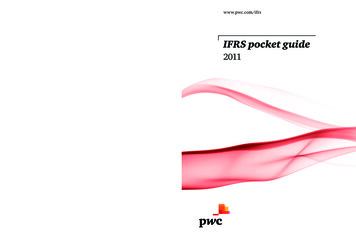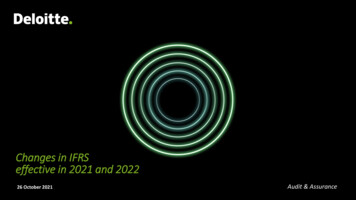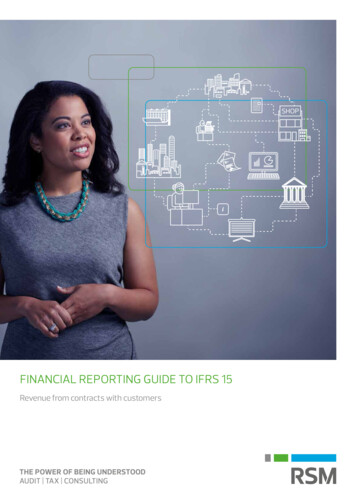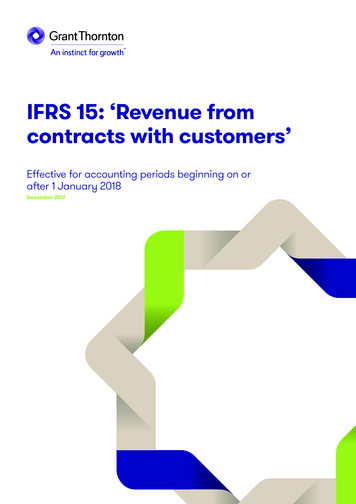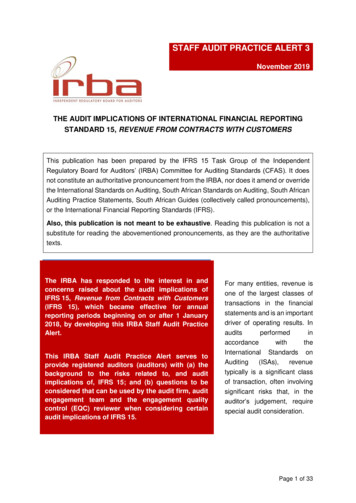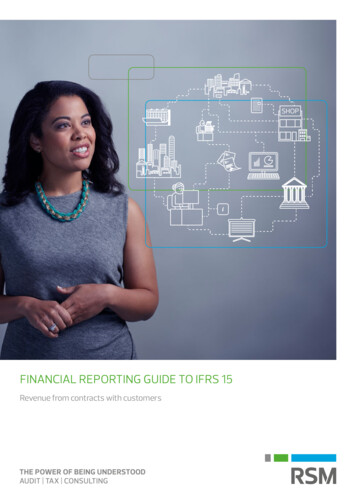
Transcription
Paper SAS0724-2017Modeling Best Practices – An IFRS 9 Case StudyPeter Baquero, Ling Xiang, SAS Institute Inc.ABSTRACTA successful conversion to the International Financial Reporting Standards (IFRS) standard known asIFRS 9 can present many challenges for a financial institution. We discuss how leveraging best practicesin project management, accounting standards, and platform implementation can overcome thesechallenges. Effective project management methodology ensures business stakeholders are activelyengaged during the implementation of the solution. Business partnership with the implementation teamand enablement for business stakeholders are vital to the success of the solution. Project managementmethodology must focus on effectively defining success criteria, all major decision points, and thoroughdocumentation of the platform and traceability for unique configuration directly to specific businessrequirements. Understanding the nuances of the IFRS 9 standard, specifically the impact of bucketing allfinancial assets according to their cash flow characteristics and business models, is crucial to ensuringthe design of an efficient and robust reporting platform. Credit impairment is calculated at the instrumentlevel, and can both improve or deteriorate. Changes in the level of credit impairment of individual financialassets enters the balance sheet as either an amortized cost, other comprehensive income, or fair valuethrough profit and loss. Introducing more volatility to these balances increases the volatility in keyfinancial ratios used by regulators. A robust and highly efficient platform is essential to process thesecalculations, especially under tight reporting deadlines and the possibility of encountering challenges.Understanding how the system is built through the project documentation will ensure ongoing scalabilityand adaptability.INTRODUCTIONEnsuring that the appropriate impairment models are being used in an IFRS 9 solution can be achallenge. The challenge comes from the principle-based nature of IFRS 9, which includes qualitativecomponents of credit risk. Furthermore, implementing an IFRS 9 solution occurs over the span of monthsduring which the nature of the organization, the marketplace, or even the requirement can change. Thesechallenges can be mitigated through a combination of appropriate project management methodology,understanding how the IFRS 9 standards are applicable to your organization, and a highly adaptabletechnology stack.PROJECT MANAGEMENT METHODOLOGYThe two most common project management methodologies are the waterfall and agile. A commonperception is that these methodologies are mutually exclusive; a project should use either the waterfallmethodology or the agile methodology (see Figure 1 Traditional Project Management MethodologyDichotomy). In reality, these methodologies represent a spectrum (see Figure 2 Project ManagementMethodology Spectrum). A project can be fully waterfall or fully agile but most often will incorporatecomponents of both methodologies. The waterfall and agile project management methodologies aretoolkits and project managers should leverage components of each to create a hybrid approach to enablethe most effective delivery.1
Figure 1 Traditional Project Management Methodology DichotomyRequirementsDeployRequirementsDesign BuildTestTestDesignDeployBuildFigure 2 Project Management Methodology SpectrumAn additional dimension must be added to the project management methodology to fully represent aproject’s goal: enablement (see ). The enablement dimension is a measure of how involved the businessteam are in the deployment of a new solution. At the top of the enablement dimension is fully coached.Fully coached represents a business team who partner with the implementation team throughout theproject and thoroughly understand the new solution as it as being implemented. As a result, the businesspartners believe that the new solution meets their requirements and develop ownership of the solutionthroughout the implementation.2
Figure 3 Project Management QuadrantThe implementation team’s fundamental responsibility is to empower the business to realize maximumvalue from the solution. A solution implementation is a beginning, not an end. For it is the end of theimplementation where the recognition of value begins. An optimal solution implementation enables fullycoached business partners to scale value from the solution beyond any limits.At the bottom of the enablement dimension is black box. This represents the implementation of a solutionwith minimal partnering from the business. All development and configuration is done before the solutionis handed over to the business. Adoption by the business community is challenging and stakeholders willlikely resist ownership.Barring any overriding considerations, the optimal position for a project along these quadrants is as closeto fully coached as possible and as close as possible to the mid-point between waterfall and agile. A fullycoached business team will achieve full adoption of the solution as part of the implementation. Likewise, afully coached business team will help identify and resolve undiscovered requirements. The continuallyevolving nature of requirements is why a hybrid of the waterfall methodology and agile methodology isideal. The structure provided by the waterfall methodology (see Figure 4 Traditional Waterfall Phases)provides an excellent framework to layout the overall project plan. The combination with agilemethodologies occurs by using agile approaches within waterfall phases (see Figure 5 Waterfall Phaseswith Embedded Agile).3
Figure 4 Traditional Waterfall PhasesFigure 5 Waterfall Phases with Embedded AgileIn practice this means that the solution is developed in smaller, discrete components. Each of thesecomponents is tested as they are ready. The testing is against not just documented technicalrequirements but also business fit. The challenge with any new solution is fully discovering allrequirements for using a new technology. Business fit represents that gap; the unknown unknowns. Asnew requirements are fleshed out of business fit, they are prioritized against existing requirements andtheir impact to the overall project design is determined. If the new requirements are determined to be4
necessary, given those considerations, that component reenters the implementation phase. Once all ofthe components have been completed, the solution enters the end to end validation stage and is testedend to end against existing requirements and for business fit. Gaps enter the requirements and designphases and are evaluated against overall design for fit and cost/benefit.The key drivers in developing impairment models for an IFRS 9 solution are data quality and datagovernance. These two drivers are highly correlated. If source system or repository data is of poor qualityand requires extensive transformation and enrichment, the need for data governance grows. Asregulatory reporting matures, regulators are looking at not whether the numbers can be produced, buthow they were produced. This is especially true for an IFRS 9 solution since IFRS9 is more principlebased than rule-based. The business will have to be able to justify exactly how it has arrived at thenumbers which it is reporting.IFRS 9 STANDARDDetermining the appropriate impairment modeling methodologies for IFRS 9 begins with understandingthe requirements of the standard. IFRS 9 aims to provide “ more timely recognition of loan losses and isa single model that is applicable to all financial instruments subject to impairment accounting.”(IFRSFoundation 2014). IFRS 9 accomplishes this through a three-phase process: Classification andMeasurement, Impairment, and Hedge Accounting. The focus of this paper will be on Classification andMeasurement, and Impairment. Hedge Accounting will not be covered.The Classification and Measurement phase sorts financial assets into their appropriate IFRS 9 categoriesand determines the appropriate valuation methodology. As a result, there is “ a single impairment modelbeing applied to all financial instruments removing a source of complexity associated with previousaccounting requirements.”(IFRS Foundation 2014). Classification is driven by (1) the business model formanaging the financial assets and (2) the contractual cash flow characteristics of the financial asset.Based on its classification a financial asset will be measured at either (1) amortized cost, (2) fair valuethrough profit or loss, or (3) fair value through other comprehensive income. Figure 6 Process forDetermining the Classification and Measurement of Financial Assets presents the Classification andMeasurement flow chart provided by IFRS Org.Figure 6 Process for Determining the Classification and Measurement of Financial Assets5
The business model of a financial asset tests the objective of holding the financial asset. The SPPI testdetermines if an institution is holding the financial asset to collect solely payments of principle andinterest. These instruments can be measured at either amortized cost or fair value through profit or lossby invoking a one-time, irrevocable fair value election.If a financial asset is held solely for sale it is measured at fair value through profit or loss. If a financialasset is held to collect contractual cash flows and for sale then it is measured as fair value through profitor loss, unless a one-time, irrevocable election to measure at fair value through other comprehensiveincome.The Impairment phase requires that expected credit losses are accounted for when a financial instrumentis first recognized if it is not measured at fair value through profit or loss. It also lowers the threshold forrecognition of full lifetime expected losses. This means that credit losses are calculated earlier and morefrequently. IFRS 9 requires a dual measurement approach; a 12 month expected credit loss calculation ora lifetime expected credit loss calculation. Financial assets that are currently performing since initialrecognition have their impairment calculated for the following 12 months of expected credit losses. If thereis a change in credit quality since initial recognition the impairment model changes to lifetime expectedcredit losses. A change in credit quality includes underperformance as well as non-performance.Impairment modeling can occur across a spectrum, from a basic approach to an advanced approach. Abasic approach to impairment modeling is to use management judgment to determine provision. Whilethis approach greatly simplifies the impairment modeling process it is not easily verifiable in terms ofaccuracy or appropriateness and so is not likely to be accepted by regulators.An intermediate approach to impairment modeling generates a probability of default using simplestatistical averages with flat loss given default assumptions. Loss curves are generated using externalbenchmarks and economic forecasts are included as a management overlay. This is more likely to beaccepted by the regulators because of the quantitative valuation of losses. However, the simplisticprobability of default calculation will most likely not be an acceptable long term approach.An advanced impairment modeling approach would include robust models to incorporate forecasts ofmacroeconomic conditions used to adjust loss curves. Also, probability of default, loss given default, andexposure at default curves are updated with both internal and external data. While the regulators wouldbe very supportive of this approach, explaining the results to non-statisticians such as investors andsenior management can be challenging. Maintaining a system this robust and complex also requires asignificant dedication of resources.The correct impairment modeling approach will be determined by the unique complexity of eachorganization, the nature of the organization’s financial asset portfolio, and the macroeconomic factors towhich the organization is subject. Since IFRS 9 is a new, principle-based reporting requirement that canrequire a range of impairment calculation approaches at the loan and portfolio level an iterative projectmanagement approach is highly recommended. Requirements might not be fully defined at the onset ofthe project. Furthermore, the adaptability and flexibility of the SAS technical solution allows for multiplesolutions for a single requirement.TECHNICAL SOLUTIONFigure 7 Software Components in SAS IFRS 9 Solution showcases the software components of SASIFRS 9 solution and data flow of the Expected Credit Loss process. There are three layers: datamanagement, analytics/process management, and reporting.6
Figure 7 Software Components in SAS IFRS 9 SolutionSAS Data Integration Studio is used to prepare data to be consumed by downstream processes. SAS Risk Modeling Workbench and Model Implementation Platform is leveraged to create and implementmodels. Once models are executed, loan-level data flow into SAS Business Rules Manager to gothrough stage allocation. At this step, the ECL for each instrument has been evaluated and eachinstrument is assigned an appropriate stage. They will be aggregated according to specific hierarchies(for example geo, organizational chart, and so on) and loaded into SAS Risk and Finance Workbench.Management can review aggregated ECL at different levels and apply overlay if needed. SAS VisualAnalytics can be used for internal/management reporting. The discrete interactions of these componentsare illustrated in Figure 8 Data Flow in SAS IFRS 9 Solution.7
Figure 8 Data Flow in SAS IFRS 9 SolutionFigure 8 Data Flow in SAS IFRS 9 Solution also illustrates the upstream and downstream data feeds forthe IFRS 9 solution. SAS Risk and Finance Workbench can be leveraged to produce regulatory reportsas those reports templates are pre-built and are shipped with the solution.CONCLUSIONGathering all of the requirements upfront for and IFRS 9 implementation is challenging since it is a newimpairment calculation process that is principle based. Therefore, a hybrid of waterfall and agile projectmanagement methodologies is the optimal approach to ensure a successful implementation.Waterfall methodology should be used to provide the broad project structure of gathering requirements,design, implementation, testing, and maintenance. Agile project management methodology should beincorporated at the implementation/testing phase. This iterative process will allow for undiscoveredrequirements to be identified and evaluated.Impairment model methodologies and effectiveness will be limited by the source data quality and theappetite for data governance activities. Data governance will have to be enhanced if source data requiresextensive transformation or enrichment. Furthermore, the principle-based nature of the IFRS 9 standardmeans there are qualitative factors that will have to be considered in the final impairment calculations.SAS offers a highly flexible and adaptable technology stack to address each organization’s unique needto capture asset information and corresponding impairment calculations. Input data can be transformedand enriched at multiple points in the platform with the appropriate corresponding data governance tomeet impairment modeling needs. Calculated impairment model results can be modified to account forqualitative factors also with the appropriate corresponding data governance.REFERENCESIFRS Foundation. 2014 “IFRS 9 Project Summary July 2014”. Accessed February 27, 2017.Available ect-Summary-July-2014.pdf.CONTACT INFORMATIONYour comments and questions are valued and encouraged. Contact the author at:Peter BaqueroSAS Consulting404.825.9266Peter.Baquero@sas.comLing XiangSAS Consulting919.531.2401Ling.Xiang@sas.comSAS and all other SAS Institute Inc. product or service names are registered trademarks or trademarks ofSAS Institute Inc. in the USA and other countries. indicates USA registration.Other brand and product names are trademarks of their respective companies.8
IFRS 9 STANDARD Determining the appropriate impairment modeling methodologies for IFRS 9 begins with understanding the requirements of the standard. IFRS 9 aims to provide " more timely recognition of loan losses and is a single model that is applicable to all financial instruments subject to impairment accounting."(IFRS Foundation 2014).

